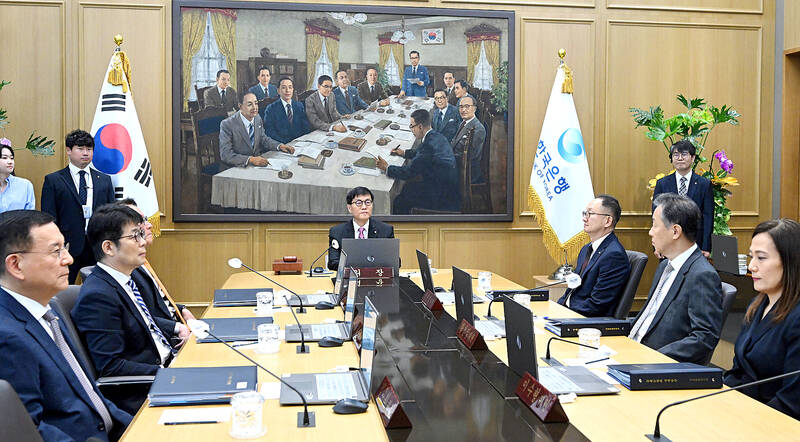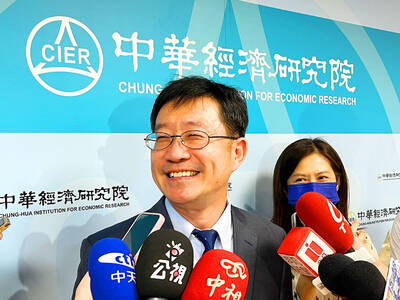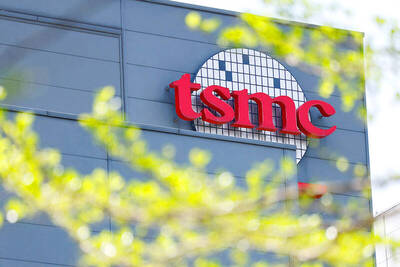The Bank of Korea (BOK) yesterday flagged the likelihood of more interest rate cuts to come after trimming borrowing costs and slashing this year’s growth forecast as US President Donald Trump’s tariffs and political turmoil weigh on the South Korean economy.
The central bank lowered its seven-day repurchase rate by a quarter percentage point to 2.5 percent and almost halved its growth forecast for this year to 0.8 percent from its projection in February. That move largely reflects the impact of the US trade tariffs rolled out since then, and while their legality is currently in dispute, South Korea’s trade-reliant economy is among those most at risk if they come into full effect.
“Since growth momentum has weakened more significantly than initially expected, we believe there’s a possibility rates will be cut more than we thought going forward,” BOK Governor Rhee Chang-yong told a news briefing following the decision.

Photo: EPA-EFE
The widely expected rate cut, the fourth since the autumn, comes just five days before the nation chooses a new leader to take on the challenges of reviving the economy and dealing with Trump.
Front-runner Lee Jae-myung of the Democratic Party has pledged at least 30 trillion won (US$21.8 billion) in stimulus to support households and small businesses. His conservative rival, Kim Moon-soo, said he would discuss a supplementary budget of around the same magnitude aimed at public welfare.
Even with those extra spending plans being flagged by the leading candidates, Rhee warned of the likely need for further stimulus next year in another indication of the difficulties the economy faces. Still, greater help from the government may temper the need for further BOK action.
“A downward revision of the growth forecast seemed inevitable due to the impact of tariffs and the slowing down of exports,” Kiwoom Securities Co analyst Ahn Yea-ha said. “I expect the base rate to come down to 2.25 percent this year, with perhaps one more cut next year, bringing it down to around 2 percent in total.”
The bank had long appeared ready to lower borrowing costs after the economy slipped into reverse in the first quarter, with most recent indicators showing little sign of a rebound. Last month, all six board members were open to a rate cut within three months in what appeared to be a clear signal that action was coming this month.
Rhee said that four members could now see lower rates in the coming three-month period, a likely indication that the central bank would keep a one-cut a quarter pace for the time being. Still, he also said rates would likely not fall below 2 percent for now.
“The BOK’s decision today was broadly more dovish than our expectation,” Barclays Bank PLC economist Bumki Son said. “However, their caution against going below 2 percent in the near-term still strikes a note of caution.”
Son sees the next cuts coming in October and February.
In addition to weak exports, subdued investment and faltering consumption pointing to an economy in need of support, the recent appreciation of the won likely gave the central bank additional scope to resume monetary easing without stoking inflation. The currency recently climbed to a seven-month high against the US dollar, after months of volatility previously restrained the BOK’s options.
The presidential election on Tuesday adds a layer of political sensitivity to the rate cut. The vote follows the ousting of former South Korean president Yoon Suk-yeol last month, after his botched martial law triggered a constitutional crisis and economic uncertainty.
“The prospect of aggressive fiscal stimulus under a new government following next week’s presidential election may reduce the pressure on monetary policy to carry the burden alone,” Bloomberg economist Hyosung Kwon said.

WEAKER ACTIVITY: The sharpest deterioration was seen in the electronics and optical components sector, with the production index falling 13.2 points to 44.5 Taiwan’s manufacturing sector last month contracted for a second consecutive month, with the purchasing managers’ index (PMI) slipping to 48, reflecting ongoing caution over trade uncertainties, the Chung-Hua Institution for Economic Research (CIER, 中華經濟研究院) said yesterday. The decline reflects growing caution among companies amid uncertainty surrounding US tariffs, semiconductor duties and automotive import levies, and it is also likely linked to fading front-loading activity, CIER president Lien Hsien-ming (連賢明) said. “Some clients have started shifting orders to Southeast Asian countries where tariff regimes are already clear,” Lien told a news conference. Firms across the supply chain are also lowering stock levels to mitigate

IN THE AIR: While most companies said they were committed to North American operations, some added that production and costs would depend on the outcome of a US trade probe Leading local contract electronics makers Wistron Corp (緯創), Quanta Computer Inc (廣達), Inventec Corp (英業達) and Compal Electronics Inc (仁寶) are to maintain their North American expansion plans, despite Washington’s 20 percent tariff on Taiwanese goods. Wistron said it has long maintained a presence in the US, while distributing production across Taiwan, North America, Southeast Asia and Europe. The company is in talks with customers to align capacity with their site preferences, a company official told the Taipei Times by telephone on Friday. The company is still in talks with clients over who would bear the tariff costs, with the outcome pending further

Six Taiwanese companies, including contract chipmaker Taiwan Semiconductor Manufacturing Co (TSMC, 台積電), made the 2025 Fortune Global 500 list of the world’s largest firms by revenue. In a report published by New York-based Fortune magazine on Tuesday, Hon Hai Precision Industry Co (鴻海精密), also known as Foxconn Technology Group (富士康科技集團), ranked highest among Taiwanese firms, placing 28th with revenue of US$213.69 billion. Up 60 spots from last year, TSMC rose to No. 126 with US$90.16 billion in revenue, followed by Quanta Computer Inc (廣達) at 348th, Pegatron Corp (和碩) at 461st, CPC Corp, Taiwan (台灣中油) at 494th and Wistron Corp (緯創) at

NEGOTIATIONS: Semiconductors play an outsized role in Taiwan’s industrial and economic development and are a major driver of the Taiwan-US trade imbalance With US President Donald Trump threatening to impose tariffs on semiconductors, Taiwan is expected to face a significant challenge, as information and communications technology (ICT) products account for more than 70 percent of its exports to the US, Chung-Hua Institution for Economic Research (CIER, 中華經濟研究院) president Lien Hsien-ming (連賢明) said on Friday. Compared with other countries, semiconductors play a disproportionately large role in Taiwan’s industrial and economic development, Lien said. As the sixth-largest contributor to the US trade deficit, Taiwan recorded a US$73.9 billion trade surplus with the US last year — up from US$47.8 billion in 2023 — driven by strong